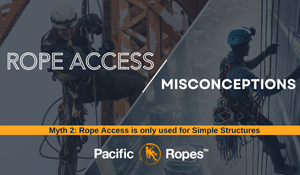A whopping 64 temperature records were broken in B.C. this summer and it is Vancouver’s hottest summer on record. BC has also received several “High Risk” to “Very High Risk” air quality heat index statuses throughout the month of July due to rampant wildfires burning throughout the Province. It’s incredible to think we still have August ahead of us with the heat not anticipated to dissipate and our firefighters still currently battling over a 150 wildfires Province wide. So, what does this mean? Well, for our rope techs, this is a unique season to take seriously when preparing for and being on an outdoor worksite.
Seasonal heat of this sort is a powerful hazard and can cause a number of physically ailing symptoms (of course, in our field, this is only exacerbated by carrying 20 pounds of equipment in full length clothing while abseiling hundreds of feet repetitively). According to Worksafe BC, Rope Access categorically falls under a “Heavy Workload” with high physical exertion, which means rope techs are at the greatest risk for heat stress on any worksite experiencing higher than usual environmental stress. Your ears should immediately perk-up when you hear the words “RECORD BREAKING HEAT” as this indicates a good possibility that the conditions you will be working in will adversely affect your body due to a lack of acclimatization.
Physically, all techs need be aware of experiencing the following symptoms when working in high heat and poor air quality:
Heat Stroke/Heat Exhaustion/Poor Air Quality:
- Dizziness
- Confusion
- Fatigue
- Muscle cramps
- Nausea
- Rapid breathing
- Increased heartrate
- Difficulty breathing
- Cardiac arrest
The symptoms of dehydration are also to be noted here. These include:
- Increased thirst
- Dry mouth
- Weakness
- Dizziness
- Heart palpitations
- Confusion
- Fainting
- Inability to sweat
- Decreased urine output
Preventing these symptoms is important for all techs and site supervisors to monitor and manage. To be our best and safest self on rope, we MUST employ best practice in health safety. This is non-negotiable in our industry.
Here are some ways to prevent these symptoms:
- HYDRATE, HYDTRATE, HYDRATE. Make sure you have a securable water bottle to carry while on rope and pack a frozen water bottle for consumption when off rope. BE PREPARED! This means hydrating before, during, and well after being on site. (Petzl’s Z52 Stainless Steel water bottle is a solid, securable rope water bottle we recommend)
- Wear clean, light colored, loose-fitting clothing made of breathable fabric. If the company that has contracted you requires you to wear specific apparel, discuss this matter with the appropriate contact
- Take breaks often and well out of the sun
- Use waterproof sunscreen and apply 1 hour before showing up on site
- Advise your supervisor if you have experienced heat stroke previously as you will be at an increased risk for recurrence
- Avoid alcohol and illicit drug use during work periods as they increase dehydration and increase internal body heat while decreasing the body’s ability to lose heat
- Advise your supervisor of any chronic skin disorders as they may worsen when exposed to heat
- Advise your supervisor of any medical conditions or treatments you are currently undergoing. For instance, heart problems and low-sodium diets weaken the body’s ability to efficiently remove excess heat
- Advise your supervisor of any medication you are currently taking as they can have dangerous side effects when under the influence of excessive heat
- ** ROPE EXPERT TIP** Our own Tim Zagiel recommends using the CMC Rescue “Sunbrerro” which fits over a standard helmet and blocks the sun (and rain) from your neck, face, and upper back
- Let us not forget that taking care of our physical shape year round can better prepare us for any worksite conditions. In this case, individuals who are more physically fit are better able to cope with heat
- And, specifically for supervisors, making sure that rope routes are timed correctly and spatially working around the sun is crucial. This may mean working earlier in the morning or into the evening, and/or timing your work areas correctly to avoid the direct sun
- As a tech, remember, it is also your right to refuse work if the weather conditions are adversely affecting your health
Before each work day, your supervisor should cover a Field Level Risk Assessment to communicate all hazards that put you and your team at risk each day—this is an excellent opportunity to discuss your health and safety concerns.
Remember, in our industry, safety is of the upmost importance and your physical health is a major contributor to your team’s success on rope. So, as we sweat into the summer months ahead, make sure you are regularly assessing your body’s health in these hot temperatures, and, if you are experiencing poor air quality simultaneously, be sure to stay mindful of your cardiovascular health. If at any time you experience any of the symptoms listed above, please visit a health care professional and notify your supervisor of your physical condition immediately. Only you can assess the way your body feels and reacts to these conditions; so, stay aware and make your body’s health a top priority this summer. (Being the guy or gal to show up on site with a few extra cold bottles of water can’t hurt either).
From all of us at Pacific Ropes- Stay Cool and Stay Safe out there.
SEE YOU ON THE ROPES!




